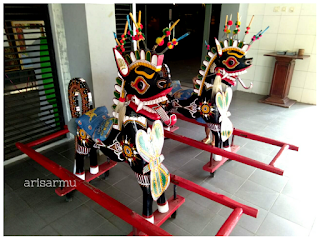Arisarmu - Visitors to West Nusa Tenggara State Museum have a chance to see and learn about a natural and cultural heritage as the source of history and science.
As it's noted in the pamphlet, the museum which was established on January 20, 1982, classified as a general museum for it has not only one kind of collection but until ten kinds of collections, such as geological, biological, ethnographic, archaeological, historical, numismatic and heraldic, philological, ceramology, technological and art collections.
 |
| West Nusa Tenggara State Museum |
Here are some of many items exhibited that you can see and learn at West Nusa Tenggara State Museum:
The People and The Culture of West Nusa Tenggara
West Nusa Tenggara Province, which consists of two main islands, Lombok and Sumbawa and other smaller islands (Gilis), covers the total area of 20,513 km2.
The native inhabitants of Lombok island are the Sasak ethnic group, while on Sumbawa island there are two ethnic groups, the Samawa who resides in the western part, and the Mboja who dwells in the eastern part.
The other ethnic groups who inhabit in West Nusa Tenggara are Balinese, Javanese, Bugis, Banjar, and Melayu.
The Sasak community on Lombok island have a strong interaction with Javanese and Balinese, whereas the Samawa and Mboja have strong been influenced by Bugis ethnic group of South Sulawesi.
 |
| Sasak noble wedding dress |
 |
| Traditional Sumbawa wedding dress |
The History of Religious and Belief Development
Prior the coming of Hinduism and Buddhism to West Nusa Tenggara, its community embraced animism and dynamism. While Kutai, Tarumanegara and Sriwijaya Kingdoms strengthened the spread of those religions during their reign. Whereas the influence of Islam was brought by traders from Java, Sulawesi, Banten and Palembang.
Fishing Village
Bugis, makasar and Mandar fishermen have provided a strong influence to the life pattern of fishermen in West Nusa Tenggara. This evidence can be seen from the layout of its fishing villages which tend to face the sea.
Mask Art
According to Wikipedia, a mask is an object normally worn on the face, typically for protection, disguise, performance, or entertainment.
In Lombok, the mask art has long been known as a folk theatre that grows and develops among communities in rural areas. Lakon Amaq Abir and Amaq Darmi in the Kayak Sandongan are the acts story who give moral message and social criticism.
The names of the mask art characters are:
1. Idayu
2. Amaq Abir
3. Amaq Tempenges
4. Cupak
5. Ida Datu
6. Kiyai Bayan
7. Amaq Bangkol
8. Papuk Uhek
9. Raksasa
West Nusa Tenggara State Museum
Location
Jalan Panji Tilar Negara 6 Mataram, Nusa Tenggara Barat, Indonesia
Opening Hours
Tuesday to Thursday 08.00 am - 04.00 pm
Friday 08.00 am - 05.00 pm
Saturday and Sunday 08.00 am - 04.00 pm
Monday and National Holiday Closed
Admission
Adult/Child. IDR 5K (USD 0.35)
Phone : 0370-632159
Website: http://www.museumntb.com
Email : museumntb@gmail.com
Words in This Story
heritage (n) - property that is or may be inherited.
ethnographic (adj) - relating to the scientific description of people and cultures with their custom, habits and mutual differences.
numismatic (adj) - relating to or consisting of coins, paper currency and medals.
philological (adj) - pertaining to the history of literature and words.
ceramology (n) - the study of ceramics.
inhabitant (n) - a person or an animal that lives in or occupies a place.



